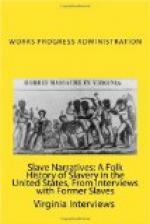Breeding
“My master didn’t force men and women to marry. He didn’t put ’em together just to get more slave. Some times other people would have women and men just for that purpose. But there wasn’t much of it in my country.
House, Stock, Parents’ Occupations
“Our house was a frame building, boxed in with one-by-twelve like we have here in the country. That was a good house with regular flooring, tongue and groove. We was raised up in a good house. Old Colonel Rice had to protect his standing. He had good stock. My father was a carriage man. He had to keep those horses clean and they always looked good. That carriage had to shine too. Colonel Rice was a high stepper. He’d take his handkerchief and rub it over the horses hair to see if they were really clean. He would always find ’em clean though when the old man got through with them. He would drive fine stock. Had some fine horses. Couldn’t trust ’em with just anybody.
“My mother was cook. She helped Mrs. Rice take care of the kids, and cooked around the house. She took care of her kids, too.
“The house we was born and bred in was built for a carriage house, but somehow or ’nother they give it to us to live in. My mother being a cook, she got what she wanted. That was a good house too. It was sealed. It had good floors. It had two rooms. It had about three windows and good doors to each room.
“We had just common furniture. Niggers didn’t have much then. My father was a good mechanic though and he would make anything he wanted. We didn’t have much, just common things. But all my people were mechanics, harness makers, shoemakers,—they could make anything. Young Sam Parker could make any kind of shoe. He made shoes for the white folks; Young Jacob was a blacksmith; he made horseshoes and anything else out of iron. He may still be living. In fact, he made anything he could get his hands on. My young uncles on my mother’s side, I don’t know much about them, because they were all mechanics. My grandfather on my mother’s side could make baskets—any kind—could make baskets that would hold water.
“My father had thirteen children. Three of them are living now. My brother lives here in the city. He was born during the war and his mother was supposed to be free when he was born.
Right After the War
“That’s what my mother told me. I can remember a long ways back myself. After the war, it wasn’t long before they began to open up schools. They used to run school three or four months a year. Both white and colored in the country had about three or four months. That is all they had. There weren’t so very many white folks that took an interest in education during slave time. Colored people got just about as much as they did right after the war. What time we went to school we went the whole day. We would come home and work in the evening like. We had pretty fair teachers. All white then at first. They didn’t have no colored till afterwards. If they did, they had so few, I never heard of them.




